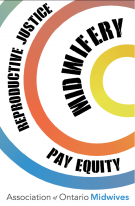Midwives - Champions of Reproductive Justice, Victims of Gender Penalty

March 8, 2017
South of the border, Trump’s attack on women and on reproductive rights has sparked outrage and re-energized feminist movements. The world witnessed as crowds gathered across the U.S. and the world – including 60,000 in Toronto – to resist the assault on women’s rights.
Reproductive justice is at the core of this mobilization. Reproductive justice speaks to the feminist tenet that no laws should restrict the ability to access reproductive health services; birth control; STI/HIV/AIDS testing, care and prevention; sex education; and, of course, access to safe and legal abortion.
Attacks on reproductive rights take many forms, including legislative. But legal rights must also be backed by access – by people being able to experience these rights in their lived realities. It’s at this junction that midwifery steps in as a conduit of reproductive justice.
In Canada, calls for abortion access and care with dignity during pregnancy and birth were taken up by the feminist movement. Just a little over two decades ago, the profession of midwifery became a part of our universal health-care system, which has meant that people have been able to access midwifery care free of charge and in accordance with a philosophy that respects the pregnant person as the central decision-maker. In many jurisdictions (but not in Ontario, not yet anyway) midwives also perform abortions.
Choice is at the very heart of midwifery care. And midwives, as front line health providers, actualize and advocate for people’s right to choice. A midwife will follow a person to home, birth centre or hospital, depending on where they want to give birth, and provide the same level of excellent clinical care regardless of setting. Through the partnership and informed choice midwives provide (two concepts deeply rooted in feminist principles), midwives are champions of reproductive justice, their pagers the beacons that call them to the side of a person who has miscarried, a person in labour, a person struggling to move into the space of caring and feeding a newborn for the first time and, in some jurisdictions, a person who has chosen to terminate a pregnancy.
Midwives worked without an increase to their compensation from the day they were brought into Ontario's health-care system in 1994 until 2005. They not only cared for clients and their growing families, but they built a profession too. And over these 11 years, a gender pay gap grew. The pay equity analysis used in 1994 to ensure fairness for a female-dominated profession was not maintained by government. Over the years, this gap continued to grow. According to the Equal Pay Coalition, the pay equity gap between men and women in Ontario stands at an alarming 30%. For midwives, the gap widens to 48%.
Three gender-dynamics have played into the devaluing and deep discounting of midwifery work: midwifery is a female-dominated profession; those receiving midwifery care are women and trans people; and midwifery responds to a health event that is physically rooted in the bodies of women and trans people. These dynamics have made midwives the victims of a gender penalty. These dynamics have led midwives to a fight against systemic gender-based discrimination at the Human Rights Tribunal of Ontario.
Midwives have always been on the front lines, defending against attacks on reproductive rights and gender-based discrimination. That’s why this weekend, for International Women's Day, midwives will be marching for reproductive justice, midwifery and pay equity.
Read the latest about the Ontario midwives' landmark pay equity case at the Human Rights Tribunal of Ontario.
